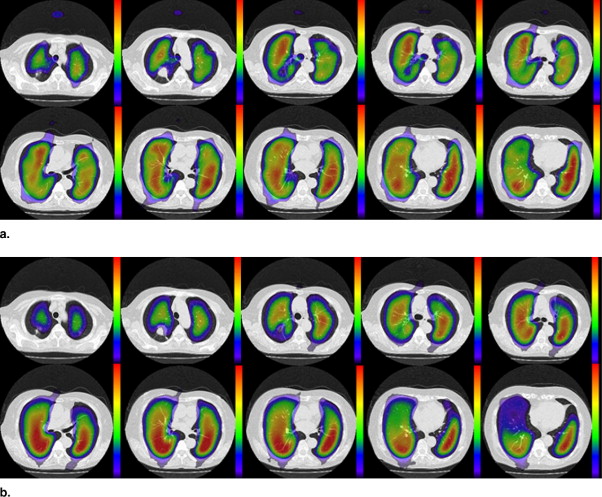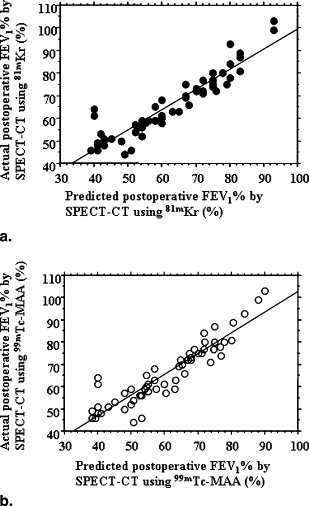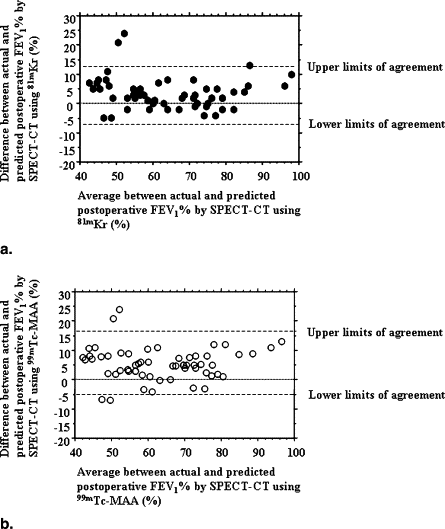Rationale and Objective
Coregistered SPECT and CT imaging (SPECT-CT) has potential for more precise evaluation of regional pulmonary function and may be useful for prediction of postoperative lung function in non−small cell lung cancer (NSCLC) patients. The purpose of the present study was to prospectively assess the capability of coregistered SPECT-CT using krypton-81m (Kr-81m) and technetium-99m−labeled macroaggregated albumin (Tc-99m MAA) for prediction of postoperative lung function of NSCLC patients compared with SPECT and planar imaging.
Materials and Methods
Sixty consecutive patients considered candidates for lung resection underwent 16-slice CT, ventilation and perfusion scintigraphy with SPECT examinations, and preoperative and postoperative measurement of FEV 1 %. In each subject, SPECT and CT data were automatically fused by using commercially available software. Each postoperative FEV 1 % value was predicted from uptakes of Kr-81m and Tc-99m MAA within total and resected lungs. Then, reproducibility coefficients and the limits of agreement between actual and each predicted postoperative lung function were statistically assessed.
Results
Reproducibility coefficients of SPECT-CT (Kr-81m: 5.1%, Tc-99m MAA: 5.2%) were smaller than those of SPECT and planar image using Kr-81m (SPECT: 7.4%, planar image: 12.1%) and using Tc-99m MAA (SPECT: 7.2%, planar image: 11.8%). The limits of agreement for SPECT-CT (Kr-81m: 3.3 ± 10.5%, Tc-99m MAA: 5.4 ± 11.0%) were also smaller than that of SPECT and planar image and small enough for clinical purposes.
Conclusions
Coregistered SPECT-CT using Kr-81m and Tc-99m MAA was able to more reproducibly and accurately predict postoperative lung function compared with SPECT and planar imaging.
Lung cancer continues to be the most common fatal malignancy ( ). In patients with non−small cell lung cancer (NSCLC), surgical resection offers the only realistic chance of cure. Most patients with lung cancer have a history of cigarette smoking, which brings risks for other conditions that may increase operative risks, including chronic obstructive pulmonary disease and coronary artery disease. Some of these patients have poor respiratory reserve so that surgery results in an unacceptable quality of life. Therefore, clinicians are frequently asked to evaluate the risks and feasibility of lung resection for patients with a combination of adverse conditions. Recently, predicted postoperative lung function and/or exercise testing has gained increasing importance in the evaluation of lung resection candidates ( ). An algorithm for functional assessment of lung resection candidates has been proposed by Wyser et al. ( ).
In current medical practice, it has been suggested that perfusion lung scan combined with spirometry can be useful for evaluation of the patient whose pulmonary function may not be adequate to tolerate resection as indicated by spirometry alone ( ). Reported correlation coefficients of predicted and actual postoperative lung function using this method vary between 0.51 and 0.92 ( ). In comparison with perfusion scintigraphy, ventilation scintigraphy is not commonly used for assessment of the degree of emphysema and prediction of postoperative lung function. However, some investigators have suggested the utility of ventilation scintigraphy as planar imaging or single-photon emission tomography (SPECT) for assessment of pulmonary emphysema and pulmonary thromboembolism and prediction of postoperative lung function ( ). In addition, a few investigators have suggested accurate assessment of regional ventilation abnormality by using krypton-81m (Kr-81m) gas similar to ultrafine aerosols with Tc-99m and/ or Tc-99m diethylenetriaminepentaacetic acid (DTPA) ( ). Although the use of ventilation and perfusion planar imaging and SPECT has been reported, they are not widely used for the assessment of lobectomy or segmentectomy because of the difficulty in interpreting the contribution of individual lobes to the overall findings, relatively longer data acquisition time, limited improvement of prediction error in candidate for lung resection, and higher costs compared with CT examination ( ).
Get Radiology Tree app to read full this article<
Get Radiology Tree app to read full this article<
Materials and methods
Subjects
Get Radiology Tree app to read full this article<
Ventilation and Perfusion Scintigraphic Examination
Get Radiology Tree app to read full this article<
Get Radiology Tree app to read full this article<
Get Radiology Tree app to read full this article<
CT Examination
Get Radiology Tree app to read full this article<
Automated Coregistration of SPECT and CT Images
Get Radiology Tree app to read full this article<
Get Radiology Tree app to read full this article<
Physiological Index and Outcome Measures
Get Radiology Tree app to read full this article<
Prediction of Postoperative Lung Function
Get Radiology Tree app to read full this article<
PredictedpostoperativeFEV1%=preoperativeFEV1%×(totallungactivity-summedradioactivityofROIsplacedovertheresectedlobe)÷totallungactivity Predicted
postoperative
FEV
1
%
=
preoperative
FEV
1
%
×
(
total
lung
activity-summed
radioactivity
of
ROIs
placed
over
the
resected
lobe
)
÷
total
lung
activity
Get Radiology Tree app to read full this article<
Get Radiology Tree app to read full this article<
PredictedpostoperativeFEV1%=preoperativeFEV1%×(1-meanradioactivityofROIsplacedovertheresectedlobeonanteriorandposteriorimages/meantotallungactivityonanteriorandposteriorimages) Predicted
postoperative
FEV
1
%
=
preoperative
FEV
1
%
×
(
1-mean
radioactivity
of
ROIs
placed
over
the
resected
lobe
on
anterior
and
posterior
images
/
mean
total
lung
activity
on
anterior
and
posterior
images
)
Get Radiology Tree app to read full this article<
Get Radiology Tree app to read full this article<
Image and Statistical Analysis of Ventilation and Perfusion SPECT-CTs
Get Radiology Tree app to read full this article<
Get Radiology Tree app to read full this article<
Get Radiology Tree app to read full this article<
Results
Get Radiology Tree app to read full this article<
Table 1
Patient characteristics
Age Mean (yr) 70 Range (yr) 45−85 Sex Male 30 Female 30 Operations Lobectomy 51 Bilobectomy 6 Pneumonectomy 3 Histological subtype Adenocarcinoma 46 Squamous cell carcinoma 8 Large cell carcinoma 4 Small cell carcinoma 2 Preoperative FEV 1 % Mean ± SD (%) 75.0 ± 17.3 Range (%) 43.0−110.0 Actual postoperative FEV 1 % Mean ± SD (%) 66.0 ± 13.7 Range (%) 39.0−93.0
Get Radiology Tree app to read full this article<
Get Radiology Tree app to read full this article<
Table 2
Degree of Tumoral Misregistration on Each Axis for Ventilation and Perfusion SPECT-CT
x-axis y-axis z-axis Mean ± SD (mm), (range) Mean ± SD (mm), (range) Mean ± SD (mm), (range) Ventilation SPECT-CT 6.8 ± 2.8 (4−13) 6.8 ± 2.8 (4−14) 10.1 ± 4.5 ⁎ † (6−20) Perfusion SPECT-CT 7.3 ± 3.0 (4−16) 7.2 ± 3.1 (4−16) 10.6 ± 4.9 ⁎ † (6−24)
Get Radiology Tree app to read full this article<
Get Radiology Tree app to read full this article<
Get Radiology Tree app to read full this article<
Get Radiology Tree app to read full this article<
Table 3
Correlation Between Actual and Predicted Postoperative FEV 1 % and Reproducibility Coefficient of Predicted Postoperative FEV 1 % on Each Method
Correlation Coefficient ( r ) Between Actual and Predicted Postoperative FEV 1 % Reproducibility Coefficient (%) SPECT-CT using Kr-81m 0.93 ⁎ 5.1 SPECT-CT using Tc-99m MAA 0.92 ⁎ 5.2 SPECT using Kr-81m 0.93 ⁎ 7.4 SPECT using Tc-99m MAA 0.92 ⁎ 7.2 Planar image using Kr-81m 0.89 ⁎ 12.1 Planar image using Tc-99m MAA 0.9 ⁎ 11.8
Get Radiology Tree app to read full this article<
Get Radiology Tree app to read full this article<
Get Radiology Tree app to read full this article<
Get Radiology Tree app to read full this article<
Get Radiology Tree app to read full this article<
Discussion
Get Radiology Tree app to read full this article<
Get Radiology Tree app to read full this article<
Get Radiology Tree app to read full this article<
Get Radiology Tree app to read full this article<
Get Radiology Tree app to read full this article<
Get Radiology Tree app to read full this article<
Get Radiology Tree app to read full this article<
Acknowledgments
Get Radiology Tree app to read full this article<
Get Radiology Tree app to read full this article<
References
1. Greenlee R.T., Hill-Harmon M.B., Murray T., Thun M.: Cancer statistics, 2001. CA Cancer J Clin 2001; 51: pp. 15-36.
2. Pierce R.J., Copland J.M., Sharpe K., Barter C.E.: Preoperative risk evaluation for lung cancer resection: Predicted postoperative product as a predictor of surgical mortality. Am J Respir Crit Care Med 1994; 150: pp. 947-955.
3. Bolliger C.T., Jordan P., Soler M., et. al.: Exercise capacity as a predictor of postoperative complications in lung resection candidates. Am J Respir Crit Care Med 1995; 151: pp. 1472-1480.
4. Wyser C., Stulz P., Soler M., et. al.: Prospective evaluation of an algorithm for the functional assessment of lung resection candidates. Am J Respir Crit Care Med 1999; 159: pp. 1450-1456.
5. Olsen G.N., Block A.J., Tobias J.A.: Prediction of postpneumonectomy pulmonary function using quantitative macroaggregate lung scanning. Chest 1974; 66: pp. 13-16.
6. Ali M.K., Mountain C.F., Ewer M.S., Johnston D., Haynie T.P.: Predicting loss of pulmonary function after pulmonary resection for bronchogenic carcinoma. Chest 1980; 77: pp. 337-342.
7. Wernly J.A., DeMeester T.R., Kirchner P.T., Myerowitz P.D., Oxford D.E., Golomb H.M.: Clinical value of quantitative ventilation-perfusion lung scans in the surgical management of bronchogenic carcinoma. J Thorac Cardiovasc Surg 1980; 80: pp. 535-543.
8. Markos J., Mullan B.P., Hillman D.R., et. al.: Preoperative assessment as a predictor of mortality and morbidity after lung resection. Am Rev Respir Dis 1989; 139: pp. 902-910.
9. Giordano A., Calcagni M.L., Meduri G., Valente S., Galli G.: Perfusion lung scintigraphy for the prediction of postlobectomy residual pulmonary function. Chest 1997; 111: pp. 1542-1547.
10. Bolliger C.T., Guckel C., Engel H., et. al.: Prediction of functional reserves after lung resection: comparison between quantitative computed tomography, scintigraphy, and anatomy. Respiration 2002; 69: pp. 482-489.
11. Ohno Y., Hatabu H., Higashino T., et. al.: Oxygen-enhanced MR imaging: Correlation with postsurgical lung function in patients with lung cancer. Radiology 2005; 236: pp. 704-711.
12. Jamadar D.A., Kazerooni E.A., Martinez F.J., Wahl R.L.: Semi-quantitative ventilation/perfusion scintigraphy and single-photon emission tomography for evaluation of lung volume reduction surgery candidates: Description and prediction of clinical outcome. Eur J Nucl Med 1999; 26: pp. 734-742.
13. Xu J., Moonen M., Johansson A., Gustafsson A., Bake B.: Quantitative analysis of inhomogeneity in ventilation SPET. Eur J Nucl Med 2001; 28: pp. 1795-1800.
14. Palmer J., Bitzen U., Jonson B., Bajc M.: Comprehensive ventilation/perfusion SPECT. J Nucl Med 2001; 42: pp. 1288-1294.
15. Hartmann I.J., Hagen P.J., Stokkel M.P., Hoekstra O.S., Prins M.H.: Technegas versus (81m)Kr ventilation-perfusion scintigraphy: A comparative study in patients with suspected acute pulmonary embolism. J Nucl Med 2001; 42: pp. 393-400.
16. Watanabe N., Inoue T., Tomioka S., Yamaji T., Endo K.: Discordant findings between krypton-81m gas and Tc-99m labeled ultrafine aerosol lung ventilation SPECT in two patients with idiopathic pulmonary fibrosis. Clin Nucl Med 1995; 20: pp. 315-317.
17. Sando Y., Inoue T., Nagai R., Endo K.: Ventilation/perfusion ratios and simultaneous dual-radionuclide single-photon emission tomography with krypton-81m and technetium-99m macroaggregated albumin. Eur J Nucl Med 1997; 24: pp. 1237-1244.
18. Stavngaard T., Mortensen J.: Assessment of ventilation inhomogenity with krypton SPECT and planar imaging. Clin Physiol Funct Imaging 2005; 25: pp. 106-112.
19. Suga K., Yasuhiko K., Zaki M., et. al.: Assessment of regional lung functional impairment with coregistered respiratory-gated ventilation/perfusion SPET-CT images: Initial experiences. Eur J Nucl Med Mol Imaging 2004; 31: pp. 240-249.
20. Suga K., Kawakami Y., Zaki M., Yamashita T., Shimizu K., Matsunaga N.: Clinical utility of coregistered respiratory-gated (99m)Tc-Technegas/MAA SPECT-CT images in the assessment of regional lung functional impairment in patients with lung cancer. Eur J Nucl Med Mol Imaging 2004; 31: pp. 1280-1290.
21. Zaki M., Suga K., Kawakami Y., et. al.: Preferential location of acute pulmonary thromboembolism induced consolidative opacities: Assessment with respiratory gated perfusion SPECT-CT fusion images. Nucl Med Commun 2005; 26: pp. 465-474.
22. Minoshima S., Berger K.L., Lee K.S., Mintun M.A.: An automated method for rotational correction and centering of three-dimensional functional brain images. J Nucl Med 1992; 33: pp. 1579-1585.
23. Minoshima S., Frey K.A., Koeppe R.A., Foster N.L., Kuhl D.E.: A diagnostic approach in Alzheimer’s disease using three-dimensional stereotactic surface projections of fluorine-18-FDG PET. J Nucl Med 1995; 36: pp. 1238-1248.
24. American Thoracic Society: Standardization of spirometry—1987 Update. Am Rev Respir Dis 1987; 136: pp. 1285-1298.
25. American Thoracic Society: Lung function testing: Selection of reference values and interpretative strategies. Am Rev Respir Dis 1991; 144: pp. 1202-1218.
26. Gass G.D., Olsen G.N.: Preoperative pulmonary function testing to predict postoperative morbidity and mortality. Chest 1986; 89: pp. 127-135.
27. Pierce R.J., Copland J.M., Sharpe K., Barter C.E.: Preoperative risk evaluation for lung cancer resection: Predicted postoperative product as a predictor of surgical mortality. Am J Respir Crit Care Med 1994; 150: pp. 947-955.
28. Santambrogio L., Nosotti M., Baisi A., Ronzoni G., Bellaviti N., Rosso L.: Pulmonary lobectomy for lung cancer: A prospective study to compare patients with forced expiratory volume in 1 s more or less than 80% of predicted. Eur J Cardiothorac Surg 2001; 20: pp. 684-687.
29. Bland J.M., Altman D.G.: Statistical methods for assessing agreement between two methods of clinical measurement. Lancet 1986; 1: pp. 307-310.
30. Wolfson M.R., Greenspan J.S., Deoras K.S., Allen J.L., Shaffer T.H.: Effect of position on the mechanical interaction between the rib cage and abdomen in preterm infants. J Appl Physiol 1992; 72: pp. 1032-1038.
31. Singh B., Panizza J.A., Finucane K.E.: Breath-by-breath measurement of the volume displaced by diaphragm motion. J Appl Physiol 2003; 94: pp. 1084-1091.
32. Takazakura R., Takahashi M., Nitta N., Murata K.: Diaphragmatic motion in the sitting and supine positions: Healthy subject study using a vertically open magnetic resonance system. J Magn Reson Imaging 2004; 19: pp. 605-609.
33. Narabayashi I., Otsuka N.: Pulmonary ventilation and perfusion studies in lung cancer. Clin Nucl Med 1984; 9: pp. 97-102.
34. Korst R.J., Ginsberg R.J., Ailawadi M., et. al.: Lobectomy improves ventilatory function in selected patients with severe COPD. Ann Thorac Surg 1998; 66: pp. 898-902.
35. Sinjan E.A., Van Schil P.E., Ortmanns P., Van den Brande F., Hendriks J.M., Eyskens E.: Improved ventilatory function after combined operation for pulmonary emphysema and lung cancer. Int Surg 1999; 84: pp. 185-189.


